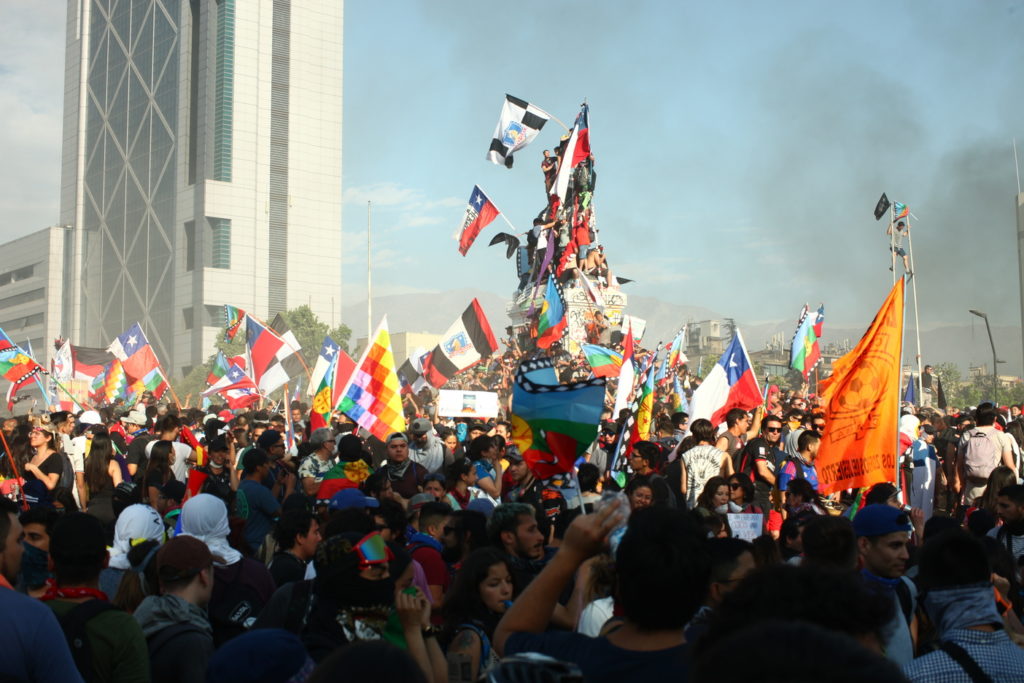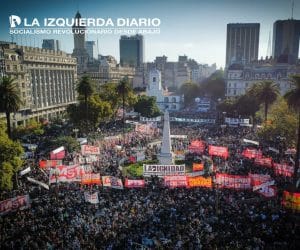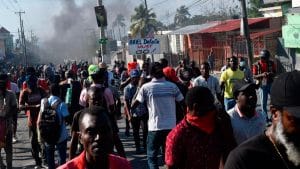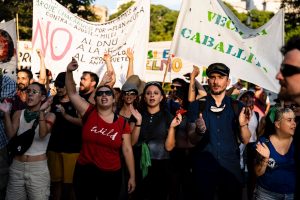The November 12 general strike, called by the Social Unity Roundtable—a coalition of organizations including the CUT union federation, the No+AFP campaign against private pension funds, the university student federation CONFECH, and the Dockworkers’ Union (UPC)—was an important demonstration of the resolve of sections of the working class, the youth, and poor people to continue the fight against Piñera and his rotten regime.
Faced with massive demonstrations, strikes, and roadblocks, the “market” quickly sounded the alarm. As soon as the stock market opened on November 12, the U.S. Dollar jumped from 750 to 800 Chilean pesos. The local stock market has already lost 14% of its value since the protests began on October 18.
November 12 was preceded by strikes and demonstrations in different parts of the country. Teachers, education workers, and preschool educators opposed to the privatization of kindergartens, along with public sector and health care workers, shut down schools, offices, and clinics the day before the general strike.
In Santiago, demonstrations at the Plaza Italia and on the Alameda that began in the morning had been attacked by police with tear gas and water cannons by the afternoon. High school students from the city’s prestigious National Institute and a dozen other schools occupied their classrooms. In Peñalolén in the city’s southeast, an occupation of part of the Cousiño Macul vineyard was brutally attacked by the military police, the carabineros.
In Valparaiso, thousands took to the streets a day before the general strike. In Concepción, more than 5,000 young people marched, only to be once again set upon by the police. In Talca, the offices of senator Juan Antonio Coloma from the Independent Democratic Union (UDI) were torched. This right-wing party, founded by Pinochet collaborators and with links to Opus Dei, has become a particular target for demonstrators, with UDI headquarters in both Santiago and Concepción having already been set alight last week. In Linares, hundreds of demonstrators destroyed the monument to Pinochet in the plazoleta “Capitán General Augusto Pinochet Ugarte,” one of the few places in Chile that still pays homage to the dictator.
Massive Demonstrations of Workers, Youth, and Social Organizations
The general strike of November 12 saw huge demonstrations take place all over Chile. The capital Santiago saw a mobilization of over 300,000 workers, young people, and local residents who gathered on the Alameda, the city’s main east-west thoroughfare, and tried to march towards the Moneda Palace before they were attacked by the police. Municipal and public sector workers—whether temporary, casual, or full-time staff—all took part, and teachers and education assistants also mobilized. Some industrial workers, as well as workers from the postal service Correos de Chile and other state-owned enterprises also took part.
In Valparaíso, over 40,000 people took to the streets. This included a massive turnout of dockworkers, as well as workers from the city’s metro system, students, young people, and local residents, along with teachers, education assistants, public sector workers and others. In Temuco, more than 30,000 people marched through the city, uniting the workers and youth with the Mapuche people, a highlight of a number of demonstrations. In Angol, the public sector, teachers, public health officials, and other workers from different areas also demonstrated. In Lonquimay, the high schools, hospitals, and clinics were all shut down by young people and public sector workers.
In Concepción, five different marches took place in the different communes, with dockworkers at the head of marches in places such as Talcahuano and Lirquén, along with workers from the Navy-owned Asmar shipyards. Some believe as many as 200,000 people took part here. Workers from Correos de Chile demonstrated on the Avenida O’Higgins. Later in the afternoon some confrontations occurred and a fire in the provincial government building in Concepción broke out.
In Punta Arenas, there were over 10,000 people in the city’s streets, with workers from the Mina Invierno coal mine, health workers, education workers, public sector workers, kindergarten teachers, workers from the Asmar shipyards, workers from the Integra fish processing plant, the state child protection services (Sename), and workers from the southern port. In Puerto Natales, unions at Unimarc closed two supermarkets. In La Serena, more than 10,000 people marched through the centre. In Arica, about 10,000 people marched, and a few hundred demonstrators jeered at the soldiers of the Arica regiment.
Hundreds of Roadblocks and Barricades Set Up Across the Country
The general strike included more than huge demonstrations across the country. From the early hours of November 12, hundreds of roadblocks and barricades were set up across the country. For instance, Highway 5, which connects Peru in the north with Santiago, was cut by barricades at places such as Pozo Almonte (Tarapacá), La Calera (Valparaíso), Purranque (Los Lagos), and Pargua (Los Lagos).
Santiago saw dozens of roadblocks and barricades. In Plaza de Maipú in the city center, hundreds of demonstrators gathered in the early morning to cut off traffic and begin marching. Other main roads, such as the Avenida Américo Vespucio and Avenida Santa Rosa were blocked by hundreds of people. The Highway 5 North was blocked in both directions by barricades in the Llay Llay area, while the Autopista del Sol tollway that runs to Valparaíso was blocked at several points. Outside the Estación Central metro station, the Ukamau residents’ movement blocked the Alameda, the main road that runs through the center of the city, and was attacked by police. In the south of the city, Gran Avenida was blocked from 9 am by hundreds of workers from Barrio Barros Luco and other hospitals, and students, who blocked the streets and then marched towards the Moneda Palace. The southwestern commune of El Monte saw both roadblocks and truck blockades. Barricades were also seen in the commune of Ñuñoa and at Avenida Irarrázaval and Diagonal Oriente above the Villa Frei metro station. In Cerro Navia to the west, blockades outside Transantiago bus stations affected various bus services on the 5 line.
Antofagasta saw dozens of roadblocks across the city as well as in the nearby city of Calama. Dozens of pickets outside various mines in the area were also set up. On Avenida Salvador Allende, the main thoroughfare that cuts through Antofagasta and heads to Calama, hundreds of young people and workers blocked the road with barricades and even ripped down police signs and security cameras.
Valparaíso saw barricades being set up from 7 am in places such as Avenida España, the coastal road that connects Valparaíso to Viña del Mar, the fish markets at Caleta Portales, as well as other points across the city. Roadblocks and blockades also occurred in La Calera, a town northeast of Valparaíso. Trucks also blocked traffic heading towards Valparaíso at El Noviciado on Highway 68, the motorway that connects Valparaíso and Santiago. A group of people attacked the cars of senators Iván Moreira and Víctor Pérez Varela from the Independent Democratic Union (UDI) as they were traveling on Highway 60 La Calera and Santiago.
Similar scenes were repeated in Concepción and its periphery. Blockades and roadblocks occurred on Avenida Costanera between Talcahuano and Concepción as well as at Plaza Acevedo in the city center. Barricades were set up in Talcahuano between Brisas del Mar and Centinela; the El Laurel-Patagual-Lota road was blocked with a barricade of cut-down trees; hundreds of demonstrators protested in front of the El Manzano prison; and barricades were seen in Coronel and on the road that joins Concepción and Penco. The road was also blocked off at Puente Perales de Talcahuano where hundreds employed at the Navy-owned Asmar shipyards work.
In the southern city of Aysén, demonstrators cut off traffic at the Carlos Ibáñez del Campo bridge in Puerto Aysén, the same place which was a flashpoint of confrontation during the Aysén rebellion of 2012. In the region of Los Lagos there were roadblocks at the Purranque tollgates on Highway 5 South, barricades in the Francke area in front of the Soprole diary company, also in the Carretera Austral (Highway 7) in the heights of Chamiza.
In the north, Iquique saw barricades and roadblocks thrown up in at least five different points in the city. In Copiapó, a large roadblock cut Highway 5 North in half at Chañaral, causing congestion that stretched for over five kilometers. In Los Ríos, Valdivia, workers of the energy company Socoepa carried out a partial blockade of Highway 5 South in the commune of Paillaco. Similar images were seen in several other cities such as Arica, Punta Arenas, Puerto Montt, and Temuco, which all experienced dozens of roadblocks and blockades of major roads and highways.
The General Strike and the Role of Bureaucracies
The general strike was most strongly felt among teachers, education assistants, kindergarten workers, public sector workers (temporary, casual and full-time), municipal workers, and health care workers in the hospitals and clinics. In the private sector, the key stoppage was the strike of dockworkers, which, according to the Dockworkers Union (UPC), brought 95% of Chile’s ports to a halt and saw dockers taking part in the big demonstrations like those in Concepción, Talcahuano, Valparaíso, Arica, Iquique, and Antofagasta.
Contradictory information has come from the mining sector. The stoppage was most fully adhered to in the Los Bronces copper mine in central Chile, the Mina Invierto coal mine in Punta Arenas, and the El Peñón gold mine in Antofagasta in the north, all of which saw a 100% halt to all production. Miners demonstrated in the mining town of El Salvador in the Atacama Desert, as well as in other mining sectors in Antofagasta. Roadblocks and blockades were also thrown up in Los Andes, where the Los Bronces mine is situated, in Rancagua, the home of the El Teniente copper mine, and the Escondida and Codelco copper mines in the Antofagasta region.
The Miners’ Federation of Chile (FMC), which brings together 8,000 workers across 15 unions in the privately-owned mining sector, declared its support for the movement but then stated that “each constituent union is free to determine and coordinate its own specific actions.”
Construction workers employed on the Curicó Hospital project south of Santiago blockaded Highway 5, and construction unions took part in demonstrations in other cities.
In the transport sector, it was the roadblocks, blockades, and barricades that caused the major disruption. Transit union leaders refused to call a mass strike on Santiago’s metro system, which, aside from only four stations, functioned normally. Neither was a strike called for the Transantiago bus system or the airports, which apart from demonstrations within the airport by public officials, also worked as normal. Santiago’s metro workers were called on to take part in demonstrations but not to stop work. However, due to the huge demonstrations and roadblocks, the decision was made to cancel all metro and Transantiago services at 5 pm. Services that were brought to a halt due to strike action included the Valparaíso Metro and interprovincial transport in Talagante and Peñaflor.
A similar situation occurred in the retail sector, where it was the demonstrations and blockades that prevented shop openings, and not a strike called by the unions. Big names such as Unimarc, Cencosud, Jumbo, Santa Isabel, Falabella, and Ripley, all opened normally and were only closed when riots broke out. Hundreds of thousands of workers wanted to take part in the demonstrations, but their union leaders did not call for either a strike or for any real mobilization.
The state-owned oil company ENAP saw strikes of its administration staff in Concón and Concepción, but its blue-collar workforce in the workshops and maintenance did not strike, although marches on the outskirts of some refineries did take place.
A Plan of Struggle Is Needed
The call for the November 12 general strike by the Social Unity Roundtable was one of the most important declarations made in recent times, and it allowed for the unification of the youth with sectors of the workers’ movement and the broader population. It is this unity that is the key to maintaining strength in the streets and advancing toward a plan of struggle that culminates in a great general strike to oust Piñera and the whole anti-people regime inherited from the dictatorship.
However, the bureaucratic leaders of the unions do not want this. They did not call for any further test of strength as part of a plan of elevating the struggle, such as a 48-hour strike in which workers do not stay at home but mobilize and take to the streets, which could then prepare for a great general strike that aims to overthrow the Piñera government.
Their plan is instead to apply pressure for “dialogue without exclusions” with the murderous government. Now that Piñera has announced a “constituent” process, they want to push for the opening of a “Constituent Assembly,” one that would still be based on the old institutions of the regime, like the much despised congress. They tell us that the government “must listen,” but this government has already shown that it is deaf, dumb, and blind to the protests that have already taken place.
They may speak in more “militant” tones, but they are only using the November 12 strike and the massive demonstrations to push for dialogue with the government and negotiations with the old regime. It is the same road that the Communist Party and the Frente Amplio (Broad Front) are traveling down. These forces are looking towards a “plebiscite” convened by the old congress of multimillionaires who only serve the interests of big business. And now they have issued a joint communiqué with the old parties of the center-left Concertación coalition to head down this road—the same parties that for thirty years have done nothing but further consolidate the legacy of the dictatorship.
The November 12 general strike has demonstrated that the power exists to go on and fight for so much more, the power to get rid of the Piñera government and this regime, and impose a truly democratic, free, and sovereign Constituent Assembly, without Piñera and without congress, so that the people themselves can really decide. For this, it is necessary to prepare a plan of struggle with further strikes, and to stop everything being prepared “from above” by convening assemblies in workplaces, and bringing them together in coordinating committees such as the Emergency and Protection Committees in Antofagasta, in order to unify the struggle against the government and the regime. This would pose the need to move towards a genuine indefinite general strike, with roadblocks and massive demonstrations, which puts the government and the bosses on the ropes.
This article is based on reports from La Izquierda Diario Chile that appeared on November 12.










